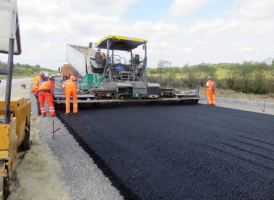SUSTAINABLE PRACTICES IN HIGHWAY CONSTRUCTION AND MAINTENANCE
Highway construction and maintenance are critical aspects of modern infrastructure development, but they often come at an environmental cost. However, in recent years, there has been a growing awareness of the need to adopt sustainable practices in these sectors. Sustainable highway construction and maintenance aim to reduce the environmental impact, enhance longevity, and promote economic efficiency. Here, we explore key practices and principles that are revolutionizing the highway industry.
1. Green Materials and Technologies
The selection of environmentally friendly materials is a cornerstone of sustainable highway construction. These materials include recycled aggregates, reclaimed asphalt pavement, and sustainable concrete mixes. Additionally, the adoption of advanced technologies like warm mix asphalt and high-performance concrete allows for reduced energy consumption and carbon emissions during construction.
2. Efficient Design and Planning
Efficient design and planning are crucial for sustainable highways. This involves optimizing the alignment, reducing the number of curves, and minimizing cut and fill operations. Smart design can reduce land use, protect natural habitats, and lower the overall environmental impact of highways.
3. Erosion Control and Stormwater Management
Sustainable highway construction emphasizes the implementation of erosion control measures and effective stormwater management. These strategies prevent soil erosion, protect water quality, and mitigate the negative impacts of construction on local ecosystems.
4. Wildlife Crossings and Habitat Enhancement
Highways often disrupt wildlife habitats and migration routes. Sustainable practices incorporate wildlife crossings, such as bridges and tunnels, to allow animals to safely traverse the highway. Additionally, planting native vegetation along roadways enhances local biodiversity.
5. Energy-Efficient Lighting
Highway lighting is a significant contributor to energy consumption and light pollution. The adoption of energy-efficient lighting technologies, like LED fixtures, and the use of smart lighting systems that adjust brightness based on traffic conditions, reduce energy use and minimize light pollution.
6. Sustainable Pavement Management
Maintaining highway pavements is essential for safety and sustainability. Regular maintenance, such as crack sealing and pothole repairs, can extend the life of road surfaces and reduce the need for costly, environmentally taxing reconstruction projects.
7. Recycling and Reuse
Recycling and reusing materials during highway construction and maintenance significantly reduce the demand for new resources. Practices like in-place recycling of asphalt and concrete and using reclaimed materials for roadbeds promote sustainability.
8. Green Certification and Standards
Many countries have adopted green certification and sustainability standards for highway projects. These certifications, such as LEED for Roads, encourage contractors and agencies to meet specific environmental and sustainability benchmarks during construction and maintenance.
9. Public Transportation Integration
Promoting public transportation options and integrating them with highway systems can reduce traffic congestion and the carbon footprint of commuters. This includes developing dedicated lanes for buses and carpooling.
10. Long-Term Monitoring and Assessment
Sustainable practices extend beyond construction and maintenance. Regular monitoring and assessment of highways’ environmental impact, traffic flow, and safety help identify areas for improvement and ensure continued sustainability.
In conclusion, sustainable practices in highway construction and maintenance are vital for reducing the environmental impact, enhancing longevity, and promoting economic efficiency. By embracing green materials, efficient design, and technology, the highway industry can contribute to a more sustainable and eco-friendly infrastructure system, benefiting present and future generations. As we move forward, the adoption of these practices will continue to shape the future of transportation infrastructure.


